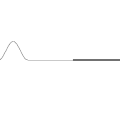Physics/A/Introduction to quantum mechanics
- Lifted from permalinks to three Wikipedia articles: Introduction to quantum mechanics, Black body, and Double-slit experiment
Newton/Gaileo's deterministic model of motion
[edit | edit source]What image would go well here?

Young's classical theory of light
[edit | edit source]
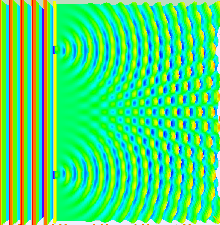
While studying medicine at Göttingen in the 1790s, Thomas Young wrote a thesis on the physical and mathematical properties of soundand in 1799, he presented a paper to the Royal Society where he argued that light was also a wave. His idea was furiously opposed because it contradicted Newton, whose views were considered sacred. Nonetheless, he continued to develop his ideas. In 1801, he presented a famous paper to the Royal Society entitled "On the Theory of Light and Colours" which described various interference phenomena, and in 1803 he performed his famous double-slit experiment (strictly speaking, a double hole experiment).
Diffraction occurs also with water and sound. Diffraction allows one to measure wavelength, and the same value of wavelength occurs for diffraction through single slits, double slits, and N-slits. The results are consistent with diffraction through a circular hole.
This experiment was repeated 100 years later by G. I. Taylor in light so dim that only one photon at a time was likely to be involved with the interference. Amazingly, one photon can interfere with itself. Shown in the figure to the right is a simulated animation of what is observed. Since the photons are passing one at a time, a time gap separates when each particle strikes the screen and creates a black dot. The experiment has been repeated in recent years with electrons, atoms, and even molecules containing over 800 atoms.
Introduction
[edit | edit source]Quantum mechanics is the science of the very small. It explains the behavior of matter and its interactions with energy on the scale of atoms and subatomic particles. By contrast, classical physics only explains matter and energy on a scale familiar to human experience, including the behavior of astronomical bodies such as the Moon. Classical physics is still used in much of modern science and technology. However, towards the end of the 19th century, scientists discovered phenomena in both the large (macro) and the small (micro) worlds that classical physics could not explain. The desire to resolve inconsistencies between observed phenomena and classical theory led to two major revolutions in physics that created a shift in the original scientific paradigm: the w:theory of relativity and the development of quantum mechanics. This article describes how physicists discovered the limitations of classical physics and developed the main concepts of the quantum theory that replaced it in the early decades of the 20th century. It describes these concepts in roughly the order in which they were first discovered. For a more complete history of the subject, see History of quantum mechanics.
Light behaves in some aspects like particles and in other aspects like waves. Matter—the "stuff" of the universe consisting of particles such as w:electrons and w:atoms—exhibits wavelike behavior too. Some light sources, such as neon lights, give off only certain frequencies of light. Quantum mechanics shows that light, along with all other forms of electromagnetic radiation, comes in discrete units, called photons, and predicts its energies, colors, and spectral intensities. A single photon is a w:quantum, or smallest observable amount, of the electromagnetic field because a partial photon has never been observed. More broadly, quantum mechanics shows that many quantities, such as angular momentum, that appeared continuous in the zoomed-out view of classical mechanics, turn out to be (at the small, zoomed-in scale of quantum mechanics) quantized. Angular momentum is required to take on one of a set of discrete allowable values, and since the gap between these values is so minute, the discontinuity is only apparent at the atomic level.
Many aspects of quantum mechanics are counterintuitive and can seem paradoxical, because they describe behavior quite different from that seen at larger length scales. In the words of quantum physicist w:Richard Feynman, quantum mechanics deals with "nature as She is – absurd". For example, the w:uncertainty principle of quantum mechanics means that the more closely one pins down one measurement (such as the position of a particle), the less accurate another measurement pertaining to the same particle (such as its w:momentum) must become.
The first quantum theory: Max Planck and black-body radiation
[edit | edit source]



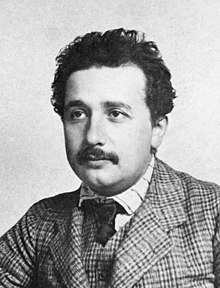

Thermal radiation is electromagnetic radiation emitted from the surface of an object due to the object's internal energy. If an object is heated sufficiently, it starts to emit light at the red end of the spectrum, as it becomes red hot. Heating it further causes the colour to change from red to yellow, white, and blue, as it emits light at increasingly shorter wavelengths (higher frequencies). A perfect emitter is also a perfect absorber: when it is cold, such an object looks perfectly black, because it absorbs all the light that falls on it and emits none. Consequently, an ideal thermal emitter is known as a w:black body, and the radiation it emits is called w:black-body radiation.
In the late 19th century, a number of formulae had been created that could somewhat describe some of the experimental measurements of thermal radiation: how the wavelength at which the radiation is strongest changes with temperature is given by w:Wien's displacement law, the overall power emitted per unit area is given by the Stefan-Boltzmann law. The best theoretical explanation of the experimental results was the Rayleigh-Jeans law, which agrees with experimental results well at large wavelengths (or, equivalently, low frequencies), but strongly disagrees at short wavelengths (or high frequencies). In fact, at short wavelengths, classical physics predicted that energy will be emitted by a hot body at an infinite rate. This result, which is clearly wrong, is known as the w:ultraviolet catastrophe. However, classical physics led to the Rayleigh-Jeans law, which, as shown in the figure, agrees with experimental results well at low frequencies, but strongly disagrees at high frequencies. Physicists searched for a single theory that explained all the experimental results.
The first model that was able to explain the full spectrum of thermal radiation was put forward by Max Planck in 1900. He proposed a mathematical model in which the thermal radiation was in equilibrium with a set of harmonic oscillators. To reproduce the experimental results, he had to assume that each oscillator emitted an integer number of units of energy at its single characteristic frequency, rather than being able to emit any arbitrary amount of energy. In other words, the energy emitted by an oscillator was quantized. The word w:quantum comes from the Latin word for "how much" (as does quantity). Something that is quantized, like the energy of Planck's harmonic oscillators, can only take specific values. For example, in most countries money is effectively quantized, with the quantum of money being the lowest-value coin in circulation. Mechanics is the branch of science that deals with the action of forces on objects. So, quantum mechanics is the part of mechanics that deals with objects for which particular properties are quantized. The quantum of energy for each oscillator, according to Planck, was proportional to the frequency of the oscillator; the constant of proportionality is now known as the w:Planck constant.
- Hidden comment: Need to be a little cautious with wording here – Planck didn't put forward his theory as a way of dealing with the ultraviolet catastrophe (and it wasn't realized until later that the ultraviolet catastrophe was an inevitable consequence of classical physics), but the ultraviolet catastrophe is why classical physics was ultimately rejected in favor of QM
The Planck constant, usually written as h, has the value of 6.63×10−34
J s. So, the energy E of an oscillator of frequency f is given by
To change the color of such a radiating body, it is necessary to change its temperature. Planck's law explains why: increasing the temperature of a body allows it to emit more energy overall, and means that a larger proportion of the energy is towards the violet end of the spectrum.
Planck's law was the first quantum theory in physics, and Planck won the Nobel Prize in 1918 "in recognition of the services he rendered to the advancement of Physics by his discovery of energy quanta". At the time, however, Planck's view was that quantization was purely a heuristic mathematical construct, rather than (as is now believed) a fundamental change in our understanding of the world.
In 1905, w:Albert Einstein took an extra step. He suggested that quantisation was not just a mathematical construct, but that the energy in a beam of light actually occurs in individual packets, which are now called w:photons. The energy of a single photon is given by its frequency multiplied by Planck's constant:
For centuries, scientists had debated between two possible theories of light: was it a w:wave or did it instead comprise a stream of tiny particles? By the 19th century, the debate was generally considered to have been settled in favor of the wave theory, as it was able to explain observed effects such as w:refraction, w:diffraction, interference and polarization. w:James Clerk Maxwell had shown that electricity, magnetism and light are all manifestations of the same phenomenon: the w:electromagnetic field. w:Maxwell's equations, which are the complete set of laws of w:classical electromagnetism, describe light as waves: a combination of oscillating electric and magnetic fields. Because of the preponderance of evidence in favor of the wave theory, Einstein's ideas were met initially with great skepticism. Eventually, however, the photon model became favored. One of the most significant pieces of evidence in its favor was its ability to explain several puzzling properties of the w:photoelectric effect, described in the following section. Nonetheless, the wave analogy remained indispensable for helping to understand other characteristics of light: w:diffraction, w:refraction and interference.
The photoelectric effect
[edit | edit source]In 1887, w:Heinrich Hertz observed that when light with sufficient frequency hits a metallic surface, it emits electrons. In 1902, w:Philipp Lenard discovered that the maximum possible energy of an ejected electron is related to the w:frequency of the light, not to its intensity: if the frequency is too low, no electrons are ejected regardless of the intensity. Strong beams of light toward the red end of the spectrum might produce no electrical potential at all, while weak beams of light toward the violet end of the spectrum would produce higher and higher voltages. The lowest frequency of light that can cause electrons to be emitted, called the threshold frequency, is different for different metals. This observation is at odds with classical electromagnetism, which predicts that the electron's energy should be proportional to the intensity of the radiation. So when physicists first discovered devices exhibiting the photoelectric effect, they initially expected that a higher intensity of light would produce a higher voltage from the photoelectric device.
Einstein explained the effect by postulating that a beam of light is a stream of particles ("w:photons") and that, if the beam is of frequency f, then each photon has an energy equal to hf. An electron is likely to be struck only by a single photon, which imparts at most an energy hf to the electron. Therefore, the intensity of the beam has no effect and only its frequency determines the maximum energy that can be imparted to the electron.
To explain the threshold effect, Einstein argued that it takes a certain amount of energy, called the w:work function and denoted by φ, to remove an electron from the metal.This amount of energy is different for each metal. If the energy of the photon is less than the work function, then it does not carry sufficient energy to remove the electron from the metal. The threshold frequency, f0, is the frequency of a photon whose energy is equal to the work function:
If f is greater than f0, the energy hf is enough to remove an electron. The ejected electron has a w:kinetic energy, EK, which is, at most, equal to the photon's energy minus the energy needed to dislodge the electron from the metal:
Einstein's description of light as being composed of particles extended Planck's notion of quantised energy, which is that a single photon of a given frequency, f, delivers an invariant amount of energy, hf. In other words, individual photons can deliver more or less energy, but only depending on their frequencies. In nature, single photons are rarely encountered. The Sun and emission sources available in the 19th century emit vast numbers of photons every second, and so the importance of the energy carried by each individual photon was not obvious. Einstein's idea that the energy contained in individual units of light depends on their frequency made it possible to explain experimental results that had hitherto seemed quite counterintuitive. However, although the photon is a particle, it was still being described as having the wave-like property of frequency. Effectively, the account of light as a particle is insufficient, and its wave-like nature is still required.
Consequences of light being quantised
[edit | edit source]The relationship between the frequency of electromagnetic radiation and the energy of each individual photon is why w:ultraviolet light can cause w:sunburn, but visible or w:infrared light cannot. A photon of ultraviolet light delivers a high amount of w:energy—enough to contribute to cellular damage such as occurs in a sunburn. A photon of infrared light delivers less energy—only enough to warm one's skin. So, an infrared lamp can warm a large surface, perhaps large enough to keep people comfortable in a cold room, but it cannot give anyone a sunburn.
All photons of the same frequency have identical energy, and all photons of different frequencies have proportionally (order 1, Ephoton = hf ) different energies. However, although the energy imparted by photons is invariant at any given frequency, the initial energy state of the electrons in a photoelectric device prior to absorption of light is not necessarily uniform. Anomalous results may occur in the case of individual electrons. For instance, an electron that was already excited above the equilibrium level of the photoelectric device might be ejected when it absorbed uncharacteristically low frequency illumination. Statistically, however, the characteristic behavior of a photoelectric device reflects the behavior of the vast majority of its electrons, which are at their equilibrium level. This point is helpful in comprehending the distinction between the study of individual particles in quantum dynamics and the study of massed particles in classical physics.
The quantisation of matter: the Bohr model of the atom
[edit | edit source]By the dawn of the 20th century, evidence required a model of the atom with a diffuse cloud of negatively charged w:electrons surrounding a small, dense, positively charged nucleus. These properties suggested a model in which electrons circle around the nucleus like planets orbiting a sun. However, it was also known that the atom in this model would be unstable: according to classical theory, orbiting electrons are undergoing centripetal acceleration, and should therefore give off electromagnetic radiation, the loss of energy also causing them to spiral toward the nucleus, colliding with it in a fraction of a second.
A second, related, puzzle was the w:emission spectrum of atoms. When a gas is heated, it gives off light only at discrete frequencies. For example, the visible light given off by w:hydrogen consists of four different colors, as shown in the picture below. The intensity of the light at different frequencies is also different. By contrast, white light consists of a continuous emission across the whole range of visible frequencies. By the end of the nineteenth century, a simple rule known as Balmer's formula showed how the frequencies of the different lines related to each other, though without explaining why this was, or making any prediction about the intensities. The formula also predicted some additional spectral lines in ultraviolet and infrared light that had not been observed at the time. These lines were later observed experimentally, raising confidence in the value of the formula.

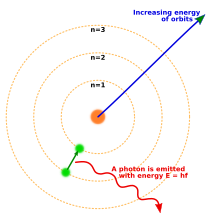
In 1913 w:Niels Bohr proposed a new model of the atom that included quantized electron orbits: electrons still orbit the nucleus much as planets orbit around the sun, but they are only permitted to inhabit certain orbits, not to orbit at any distance. When an atom emitted (or absorbed) energy, the electron did not move in a continuous trajectory from one orbit around the nucleus to another, as might be expected classically. Instead, the electron would jump instantaneously from one orbit to another, giving off the emitted light in the form of a photon.

Starting from only one simple assumption about the rule that the orbits must obey, the Bohr model was able to relate the observed spectral lines in the emission spectrum of hydrogen to previously known constants. In Bohr's model the electron simply wasn't allowed to emit energy continuously and crash into the nucleus: once it was in the closest permitted orbit, it was stable forever. Bohr's model didn't explain why the orbits should be quantised in that way, nor was it able to make accurate predictions for atoms with more than one electron, or to explain why some spectral lines are brighter than others.
Some fundamental assumptions of the Bohr model were soon proven wrong—but the key result that the discrete lines in emission spectra are due to some property of the electrons in atoms being quantised is correct. The way that the electrons actually behave is strikingly different from Bohr's atom, and from what we see in the world of our everyday experience; this modern quantum mechanical model of the atom is discussed below.
Wave-particle duality
[edit | edit source]
Broglie
[edit | edit source]
Just as light has both wave-like and particle-like properties, matter also has wave-like properties.
Matter behaving as a wave was first demonstrated experimentally for electrons: a beam of electrons can exhibit w:diffraction, just like a beam of light or a water wave. Similar wave-like phenomena were later shown for atoms and even molecules.
The wavelength, λ, associated with any object is related to its momentum, p, through the w:Planck constant, h:
The relationship, called the de Broglie hypothesis, holds for all types of matter: all matter exhibits properties of both particles and waves.
The concept of wave–particle duality says that neither the classical concept of "particle" nor of "wave" can fully describe the behavior of quantum-scale objects, either photons or matter. Wave–particle duality is an example of the principle of complementarity in quantum physics.
The double-slit experiment
[edit | edit source]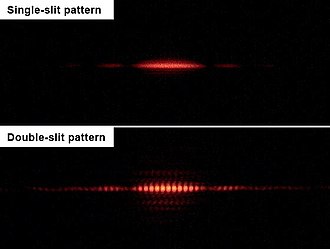
In the double-slit experiment, as originally performed by Thomas Young and w:Augustin Fresnel in 1827, a beam of light is directed through two narrow, closely spaced slits, producing an interference pattern of light and dark bands on a screen. If one of the slits is covered up, one might naively expect that the intensity of the fringes due to interference would be halved everywhere. In fact, a much simpler pattern is seen, a simple diffraction pattern. Closing one slit results in a much simpler pattern diametrically opposite the open slit. Exactly the same behavior can be demonstrated in water waves, and so the double-slit experiment was seen as a demonstration of the wave nature of light.
Variations of the double-slit experiment have been performed using electrons, atoms, and even large molecules, and the same type of interference pattern is seen. Thus it has been demonstrated that all matter possesses both particle and wave characteristics.
Even if the source intensity is turned down, so that only one particle (e.g. photon or electron) is passing through the apparatus at a time, the same interference pattern develops over time. The quantum particle acts as a wave when passing through the double slits, but as a particle when it is detected. This is a typical feature of quantum complementarity: a quantum particle acts as a wave in an experiment to measure its wave-like properties, and like a particle in an experiment to measure its particle-like properties. The point on the detector screen where any individual particle shows up is the result of a random process. However, the distribution pattern of many individual particles mimics the diffraction pattern produced by waves.
Introduction
[edit | edit source]Quantum mechanics is the science of the very small. It explains the behavior of matter and its interactions with energy on the scale of atoms and subatomic particles. By contrast, classical physics only explains matter and energy on a scale familiar to human experience, including the behavior of astronomical bodies such as the Moon. Classical physics is still used in much of modern science and technology. However, towards the end of the 19th century, scientists discovered phenomena in both the large (macro) and the small (micro) worlds that classical physics could not explain. The desire to resolve inconsistencies between observed phenomena and classical theory led to two major revolutions in physics that created a shift in the original scientific paradigm: the w:theory of relativity and the development of quantum mechanics. This article describes how physicists discovered the limitations of classical physics and developed the main concepts of the quantum theory that replaced it in the early decades of the 20th century. It describes these concepts in roughly the order in which they were first discovered. For a more complete history of the subject, see History of quantum mechanics.
Light behaves in some aspects like particles and in other aspects like waves. Matter—the "stuff" of the universe consisting of particles such as w:electrons and w:atoms—exhibits wavelike behavior too. Some light sources, such as neon lights, give off only certain frequencies of light. Quantum mechanics shows that light, along with all other forms of electromagnetic radiation, comes in discrete units, called photons, and predicts its energies, colors, and spectral intensities. A single photon is a w:quantum, or smallest observable amount, of the electromagnetic field because a partial photon has never been observed. More broadly, quantum mechanics shows that many quantities, such as angular momentum, that appeared continuous in the zoomed-out view of classical mechanics, turn out to be (at the small, zoomed-in scale of quantum mechanics) quantized. Angular momentum is required to take on one of a set of discrete allowable values, and since the gap between these values is so minute, the discontinuity is only apparent at the atomic level.
Many aspects of quantum mechanics are counterintuitive and can seem paradoxical, because they describe behavior quite different from that seen at larger length scales. In the words of quantum physicist w:Richard Feynman, quantum mechanics deals with "nature as She is – absurd". For example, the w:uncertainty principle of quantum mechanics means that the more closely one pins down one measurement (such as the position of a particle), the less accurate another measurement pertaining to the same particle (such as its w:momentum) must become.
Application to the Bohr model
[edit | edit source]De Broglie expanded the w:Bohr model of the atom by showing that an electron in orbit around a nucleus could be thought of as having wave-like properties. In particular, an w:electron is observed only in situations that permit a w:standing wave around a nucleus. An example of a standing wave is a violin string, which is fixed at both ends and can be made to vibrate. The waves created by a stringed instrument appear to oscillate in place, moving from crest to trough in an up-and-down motion. The wavelength of a standing wave is related to the length of the vibrating object and the boundary conditions. For example, because the violin string is fixed at both ends, it can carry standing waves of wavelengths , where l is the length and n is a positive integer. De Broglie suggested that the allowed electron orbits were those for which the circumference of the orbit would be an integer number of wavelengths. The electron's wavelength therefore determines that only Bohr orbits of certain distances from the nucleus are possible. In turn, at any distance from the nucleus smaller than a certain value it would be impossible to establish an orbit. The minimum possible distance from the nucleus is called the Bohr radius.
De Broglie's treatment of quantum events served as a starting point for Schrödinger when he set out to construct a wave equation to describe quantum theoretical events.
Spin is hidden (not needed here)
Development of modern quantum mechanics
[edit | edit source]Heisenberg's matrix theory
[edit | edit source]

In 1925, Werner Heisenberg attempted to solve one of the problems that the Bohr model left unanswered, explaining the intensities of the different lines in the hydrogen emission spectrum. By modifying the classical computation of intensities he managed to develop a successful model. Shortly afterwards, Heisenberg's colleague Max Born realised that Heisenberg's method could best be expressed by using the mathematical concept of matrices. Matrices have an interesting mathematics because a·b≠b·a. As shown in figure showing how to get the upper right element of the product, (ab)12=a11b12+a12b22, while (ba)12=b11a12+b12a22.
Schrödinger's wave theory
[edit | edit source]
In the same year, building on de Broglie's hypothesis, w:Erwin Schrödinger developed the equation that describes the behavior of a quantum mechanical wave. The mathematical model, called the w:Schrödinger equation after its creator, is central to quantum mechanics, defines the permitted stationary states of a quantum system, and describes how the quantum state of a physical system changes in time. The wave itself is described by a mathematical function known as a "w:wave function". Schrödinger said that the wave function provides the "means for predicting probability of measurement results".
Schrödinger was able to calculate the energy levels of hydrogen by treating a hydrogen atom's w:electron as a classical wave, moving in a well of electrical potential created by the proton. This calculation accurately reproduced the energy levels of the Bohr model.
In May 1926, Schrödinger proved that Heisenberg's w:matrix mechanics and his own wave mechanics made the same predictions about the properties and behavior of the electron; mathematically, the two theories had an underlying common form. Yet the two men disagreed on the interpretation of their mutual theory. For instance, Heisenberg accepted the theoretical prediction of jumps of electrons between orbitals in an atom, but Schrödinger hoped that a theory based on continuous wave-like properties could avoid what he called (as paraphrased by w:Wilhelm Wien) "this nonsense about quantum jumps."
Copenhagen interpretation
[edit | edit source]
Bohr, Heisenberg and others tried to explain what these experimental results and mathematical models really mean. Their description, known as the Copenhagen interpretation of quantum mechanics, aimed to describe the nature of reality that was being probed by the measurements and described by the mathematical formulations of quantum mechanics.
upcoming
[edit | edit source]The main principles of the Copenhagen interpretation are:
|
|---|
Various consequences of these principles are discussed in more detail in the following subsections. |
The rest is a bit rough
| |||
|---|---|---|---|
The Pauli exclusion principle[edit | edit source]Hidden text Application to the hydrogen atom[edit | edit source]Bohr's model of the atom was essentially a planetary one, with the electrons orbiting around the nuclear "sun." However, the uncertainty principle states that an electron cannot simultaneously have an exact location and velocity in the way that a planet does. Instead of classical orbits, electrons are said to inhabit w:atomic orbitals. An orbital is the "cloud" of possible locations in which an electron might be found, a distribution of probabilities rather than a precise location. Schrödinger was able to calculate the energy levels of hydrogen by treating a hydrogen atom's w:electron as a wave, represented by the "w:wave function" Ψ, in an w:electric potential well, V, created by the proton. The solutions to Schrödinger's equation are distributions of probabilities for electron positions and locations. Orbitals have a range of different shapes in three dimensions. The energies of the different orbitals can be calculated, and they accurately match the energy levels of the Bohr model. Within Schrödinger's picture, each electron has four properties:
 The first property describing the orbital is the w:principal quantum number, n, which is the same as in Bohr's model. n denotes the energy level of each orbital. The possible values for n are integers: The next quantum number, the w:azimuthal quantum number, denoted l, describes the shape of the orbital. The shape is a consequence of the w:angular momentum of the orbital. The angular momentum represents the resistance of a spinning object to speeding up or slowing down under the influence of external force. The azimuthal quantum number represents the orbital angular momentum of an electron around its nucleus. The possible values for l are integers from 0 to n − 1 (where n is the principal quantum number of the electron): The shape of each orbital is usually referred to by a letter, rather than by its azimuthal quantum number. The first shape (l=0) is denoted by the letter s (a w:mnemonic being "sphere"). The next shape is denoted by the letter p and has the form of a dumbbell. The other orbitals have more complicated shapes (see w:atomic orbital), and are denoted by the letters d, f, g, etc. The third quantum number, the w:magnetic quantum number, describes the w:magnetic moment of the electron, and is denoted by ml (or simply m). The possible values for ml are integers from −l to l (where l is the azimuthal quantum number of the electron): The magnetic quantum number measures the component of the angular momentum in a particular direction. The choice of direction is arbitrary, conventionally the z-direction is chosen. The fourth quantum number, the w:spin quantum number (pertaining to the "orientation" of the electron's spin) is denoted ms, with values +1⁄2 or −1⁄2. The chemist w:Linus Pauling wrote, by way of example:
It is the underlying structure and symmetry of atomic orbitals, and the way that electrons fill them, that leads to the organisation of the w:periodic table. The way the atomic orbitals on different atoms combine to form w:molecular orbitals determines the structure and strength of chemical bonds between atoms. --> Quantum entanglement[edit | edit source]Wikipedia[edit | edit source] The Pauli exclusion principle says that two electrons in one system cannot be in the same state. Nature leaves open the possibility, however, that two electrons can have both states "superimposed" over each of them. Recall that the wave functions that emerge simultaneously from the double slits arrive at the detection screen in a state of superposition. Nothing is certain until the superimposed waveforms "collapse". At that instant an electron shows up somewhere in accordance with the probability that is the square of the absolute value of the sum of the complex-valued amplitudes of the two superimposed waveforms. The situation there is already very abstract. A concrete way of thinking about entangled photons, photons in which two contrary states are superimposed on each of them in the same event, is as follows: Imagine that the superposition of a state labeled blue, and another state labeled red then appear (in imagination) as a purple state. Two photons are produced as the result of the same atomic event. Perhaps they are produced by the excitation of a crystal that characteristically absorbs a photon of a certain frequency and emits two photons of half the original frequency. So the two photons come out purple. If the experimenter now performs some experiment that determines whether one of the photons is either blue or red, then that experiment changes the photon involved from one having a superposition of blue and red characteristics to a photon that has only one of those characteristics. The problem that Einstein had with such an imagined situation was that if one of these photons had been kept bouncing between mirrors in a laboratory on earth, and the other one had traveled halfway to the nearest star, when its twin was made to reveal itself as either blue or red, that meant that the distant photon now had to lose its purple status too. So whenever it might be investigated after its twin had been measured, it would necessarily show up in the opposite state to whatever its twin had revealed. In trying to show that quantum mechanics was not a complete theory, Einstein started with the theory's prediction that two or more particles that have interacted in the past can appear strongly correlated when their various properties are later measured. He sought to explain this seeming interaction in a classical way, through their common past, and preferably not by some "spooky action at a distance." The argument is worked out in a famous paper, Einstein, Podolsky, and Rosen (1935; abbreviated EPR), setting out what is now called the w:EPR paradox. Assuming what is now usually called w:local realism, EPR attempted to show from quantum theory that a particle has both position and momentum simultaneously, while according to the w:Copenhagen interpretation, only one of those two properties actually exists and only at the moment that it is being measured. EPR concluded that quantum theory is incomplete in that it refuses to consider physical properties that objectively exist in nature. (Einstein, Podolsky, & Rosen 1935 is currently Einstein's most cited publication in physics journals.) In the same year, w:Erwin Schrödinger used the word "entanglement" and declared: "I would not call that one but rather the characteristic trait of quantum mechanics." The question of whether entanglement is a real condition is still in dispute. The w:Bell inequalities are the most powerful challenge to Einstein's claims. My way[edit | edit source] 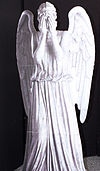
|
Footnotes
[edit | edit source]











